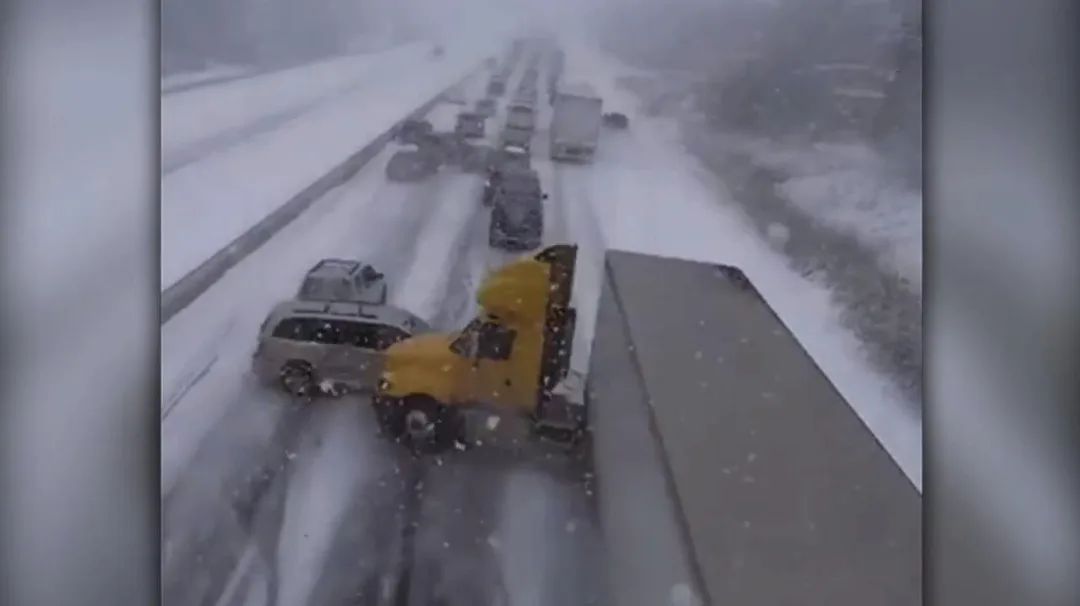
Avoiding a pileup rests on remembering these driving tips
Road conditions can deteriorate in a matter of minutes during the winter months, and if you're not prepared, it could lead to a serious collision or pileup. Officials have these tips to keep in mind when hitting the roads this season.
Viral footage of a terrifying pileup on Highway 401 in Bowmanville, Ontario a few winters ago continues to serve as a stark reminder of how fast you can lose control of your car in a snow squall.
Up to 100 vehicles were involved in the crash, including a tractor-trailer. Several people were sent to hospital, all with minor injuries, and the highway was shut down for nine hours.
Intensifying snow squalls sent visibility plunging along highways in southern Ontario, contributing to numerous accidents region-wide, and with snow squall season here again, police have some tips for drivers on how to avoid a similar pile-up.
"This is something that we see throughout the winter all of the time and typically you don't get caught by surprise, although sometimes when a snow squall comes in or a streamer comes in across the lake, it can happen very quickly," OPP Sgt. Kerry Schmidt told The Weather Network.
Speed is a major contributing factor to collisions during snow squall events and Sgt. Schmidt says once that white wall or blowing snow appears in the distance, that is the precise time drivers should start slowing down.
HOW TO REACT
"It really comes down to drivers taking a look down the road not just over the bumper, but looking far down into the distance to anticipate what's going on and if there are any changes in weather patterns, traffic patterns, traffic speed, road conditions, everything," he said. "You must adjust your driving much earlier on."
So, what's the appropriate speed when approaching a squall?
"When officers were speaking to some of the drivers that were involved in these collisions, a lot of them had said they had slowed down and were doing maybe 80 or 90 km/h, but that is far too fast," Schmidt told The Weather Network. "In these conditions, the appropriate speed might have been 20 or 30, or even less depending on how far you can see, because if you are driving into an environment where you can't see 50 metres in front of you, you need to be able to stop."
Often times it's natural instinct for a driver to slam on the brakes. However, this sets off a dangerous chain reaction. By slowing down gradually, it gives the driver behind a warning that there is something coming up ahead.
"Very often the collisions we see are vehicles losing control on off and on ramps, curves and corners," Schmidt noted. "Vehicles only have four points of contact with the ground on those tires and there's a limit to how much friction you're going to have on that. So, if you're taking a ramp too quickly, you may not be able to negotiate that curve."
Whether or not you are located near a typical snowbelt area, conditions can change rapidly at anytime without warning.
If you find yourself approaching a snow squall, Sgt. Schmidt suggests turning on your vehicle's full headlight system and if you choose to slow down, put on your four-ways to make yourself as visible as possible to other motorists on the road. Before you head out, brush any ice or snow off your vehicle, ensure all fluids are topped up and have an emergency kit on you.
As always with snow squalls, avoiding travel is the best option. Delaying a trip will also allow snowplows, salt trucks and other maintenance crews to do their job.
"We don't want to see people trying to pass snowplows and trying to cause problems with them because that can slowdown the entire clearing operation."
WATCH BELOW: IF YOU ONLY HAVE 2 WINTER TIRES, SHOULD THEY GO ON THE BACK OR FRONT?
PULLING OVER
In snow squalls pulling over to the side of the highway may seem like the safest option, but Sgt. Schmidt says that could make matters worse.
"There may be cars driving on the shoulder, unbeknownst to them that they're actually on the shoulder because they can't see the lane markings... Vehicles coming from behind may not see you until it's too late and they may be on a collision course with you," said Schmidt. "Instead, get to the next exit and then get off the highway. That will probably be a far better option for you."
BRACING FOR IMPACT
But, what if it's too late?
"In terms of bracing for impact we don't want you to lock your arms in position and make yourself all rigid, because very often that can cause more injury," he said. "If your vehicle is modern and equipped with all sorts of safety mechanisms in terms of breaking, traction control, anti-skid and so on, you can take advantage of that. It's the vehicle doing the work for you, you don't have to pump the breaks."
If you find yourself sliding or heading towards a dangerous area, Schmidt suggests finding an escape route and steering smoothly in that direction.
If you are involved in a crash and there is blowing snow, pull over if you can and stay inside the vehicle until emergency crews arrive.
"Just have that ever-present awareness and attention so that you can be prepared to respond to any emergency or crisis that may happen."
Editor's note: This article was originally published in 2017.